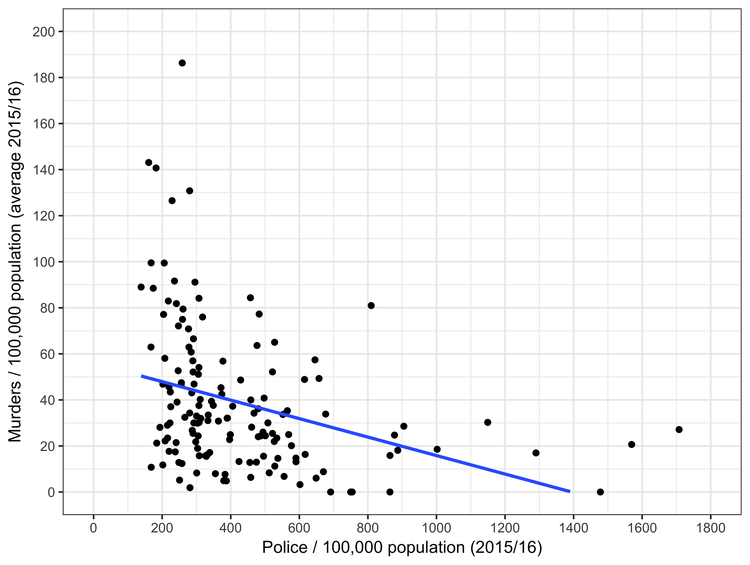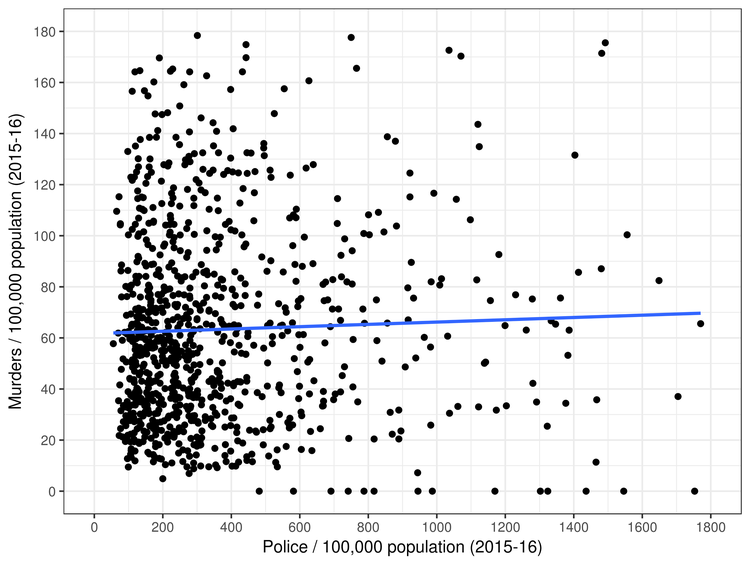

The distribution of police is highly unequal. Archive photo: Ashraf Hendricks
17 January 2018
Human rights activists have taken the Minister of Police to the Equality Court because, they claim, police resources in the Western Cape and nationally are unfairly distributed. In fact, the Social Justice Coalition (SJC), Equal Education and the Nyanga Community Policing Forum say, the deployment of police officers discriminates against black and poor people.
Are police officers unequally distributed in the Western Cape? And what about the country as a whole?
There are two obvious ways to measure how police officers are deployed:
Population Equality, which would mean that there are roughly the same number of police officers per number of people served by each precinct.
Crime-rate Equality would mean that the number of police officers per precinct is roughly proportional to the number of crimes.
As it happens, the SJC has put together a useful spreadsheet based on data from SAPS that we have used to estimate both Population and Crime-rate Equality. (You can download the spreadsheet here.)
Let’s first look at Population Equality. The table below is a small selection of Western Cape precincts (there are a total of 150 precincts).
| Precinct | Population | Officers | Per 100k |
|---|---|---|---|
| Harare | 172,475 | 239 | 139 |
| Nyanga | 202,332 | 325 | 161 |
| Ocean View | 40,392 | 88 | 218 |
| Athlone | 63,307 | 185 | 292 |
| Kensington | 25,607 | 75 | 293 |
| Elsies River | 69,691 | 206 | 296 |
| Gordons Bay | 16,572 | 51 | 308 |
| Somerset West | 57,098 | 176 | 308 |
| Parow | 60,339 | 197 | 326 |
| Melkbosstrand | 12,383 | 41 | 331 |
| Strand | 51,600 | 172 | 333 |
| Fish Hoek | 20,287 | 77 | 380 |
| Simon’s Town | 13,043 | 50 | 383 |
| Pinelands | 20,663 | 80 | 387 |
| Sea Point | 24,808 | 161 | 649 |
| Camps Bay | 5,524 | 49 | 887 |
| Cape Town Central | 35,019 | 598 | 1708 |
We can immediately see from this table that there isn’t anything close to Population Equality. The number of police per 100,000 people ranges from 139 in Harare, Khayelitsha, to 1,708 in Cape Town Central. For readers with an interest in stats, the mean is 428 per 100,000, the median is 334 and the standard deviation is 261.
Interestingly, Nyanga, the precinct which sometimes has the highest murder rate in the country, has 161 police per 100,000 people. Camps Bay, with 49 cops for 5,500 residents, has a ratio of 887 police per 100,000 people, and it only had two murders from 2013 to 2016 (the four years covered in the SAPS spreadsheet).
What about Crime-rate Equality? The most meaningful measure of crime is the murder rate. Many crimes are under-reported, but it’s hard to miss a murder. The SAPS spreadsheet gives the number of murders per precinct for 2015 to 2016. Now take a look at the graph below. Each dot is a precinct. The y-axis gives the number of murders over four years in that precinct per 100,000 people, and the x-axis gives the number of police per 100,000 people.

The blue line shows how these are correlated — in other words how the number of police changes as the number of murders increases. If there were a positive correlation — if the number of officers increased with the number of murders — the line would slope upwards from left to right. But the slope of the line shows exactly the opposite. It isn’t even flat (which would mean there’s no correlation). There is a correlation, a negative one — the number of officers decreases as the murder rate increases. Not only do we not have Crime-rate Equality, we have something approaching the exact opposite: evidence of a policy that actively favours inequality, a policy that places police officers where there are fewer murders. (For readers interested in stats the correlation coefficient is -0.34.)
There are some points to note about this analysis. Towns with small populations need a minimum contingent of officers for a police station to function. These precincts will necessarily have high ratios of police per 100,000 people. A second point is that the police in Cape Town city centre do not only serve the residents but the many thousands of people who commute to the city daily, as well as tourists. Nevertheless, these points do not come close to negating our findings.
Is this massive inequality just a Western Cape phenomenon? What about the whole of South Africa? The graph below is for all precincts in all provinces except the Western Cape. Even here we see that there isn’t Population Equality. And the Crime-rate Equality blue line is flat, meaning that there isn’t Crime-rate Equality either. But the inequality of the latter is not as bad as the Western Cape where the curve actually goes in the wrong direction. (For readers interested in stats the correlation coefficient is 0.007.)

So the activist groups are right that police officers are very unequally and unfairly distributed in the Western Cape, and also in the rest of the country, though less so.
Are police officers distributed in a way that black and/or poor people get the worst of it? This we haven’t analysed in detail. But a cursory look at the data would suggest that in the Western Cape that does appear to be the case, though there are some exceptions.
The precincts in Cape Town with the fewest officers per 100,000 people include Harare, Nyanga, Lwandle, Delft, Kraaifontein, Gugulethu and Strandfontein. Philippi East had the highest murder rate in the period covered, and it too has relatively few police officers. These are predominantly black and poor areas. By contrast, the predominantly white and wealthy areas of Claremont, Sea Point, and Camps Bay are among the precincts with the highest number of officers proportionate to population.
Thanks to Eduard Grebe for doing the graphs using R. Here is the source code and the adjusted spreadsheet we used. Table Bay Harbour has been removed from the Western Cape data because it is an outlier, but, in any case, including it would strengthen the article’s findings.